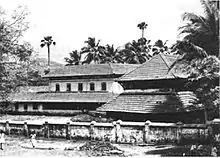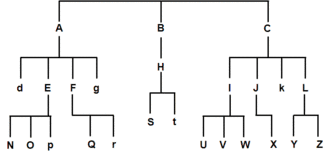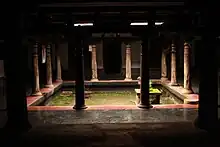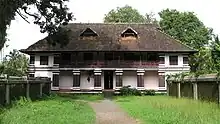

Tharavad, also spelled as Tharavadu (ⓘ) (തറവാട്), is the Malayalam word for the ancestral home of aristocratic families in Kerala especially Nairs, which usually served as the common residence for the matrilineal joint family system practiced in the state,[1][2] in which males inherited through the female line. It was classically the residence of the Jenmimar, but contemporary usage of the word is now more generic to all social classes and religions in Kerala.[3]
The German linguist Hermann Gundert, in his Malayalam—English dictionary published in 1872, defines a Tharavadu as, "An ancestral residence of land-owners and kings", and also as, "A house, chiefly of noblemen".[4] By extension, the word refers not just to the family's house but to the extended family that shares that house.
Architecture

Inseparable from the traditional concept of a tharavad is, historically, Kerala's distinctive Nālukettu architectural tradition. A classic Nalukettu tharavad would be built with four halls, each with a defined purpose, and collectively enclosing a Nadumuttam, or open-air courtyard. Wealthier and more prominent tharavads would construct mansions with multiple such atria, such as the eight-halled Ettukettu, with two nadumuttams, or Pathinarukettu, sixteen-halled with four nadumuttams, and the preserve of royal families and tharavads of similar rank. Rarely, twelve-halled Pathrandukettu were constructed. with three courtyards,[5] and there is a record of a 32-halled Muppathirandukettu being erected, although it was lost to a fire soon after construction.[6]

References
- ↑ Kakkat, Thulasi (18 August 2012). "Kerala's Nalukettus". The Hindu. Retrieved 13 December 2017.
- ↑ Kunhikrishnan, K. (12 April 2003). "Fallen tharavads". The Hindu. Retrieved 13 December 2017.
- ↑ Pannikar, K.M. (1960). "A History of Kerala 1498 - 1801". Annamalai University Press.
- ↑ Hermann Gundert (1872). A Malayalam and English Dictionary. C. Stolz. p. 434. Retrieved 15 February 2017.
- ↑ Nayar, Devu (2022). "House as Ritual: Stories of Gender, Space, and Caste in Colonial Kerala". Masters of Environmental Design Theses. 6.
- ↑ "Some Namboothiri Illams". www.namboothiri.com. Retrieved 1 December 2023.